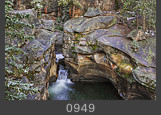 I think this image is a pretty good example of the benefits of using HDR (high-dynamic-range) techniques for landscape photography. Simply put, this involves making multiple exposures, from too light to just right to too dark, then combining them through special software to produce a result that approximates what the eye/brain system actually perceives. The reason such a technique exists is that neither film nor digital sensors are capable of registering the full range of values (light to dark) in a scene with high contrast, although our incredible eyes have no problem doing that (within extreme limits). In this image, although the light was muted and diffuse, the range of values from the snow and water to the deep shadows on the bottom-side of the rock was far more than my camera could capture. But by using HDR techniques, the result is very close to what I saw at that moment. I think this image is a pretty good example of the benefits of using HDR (high-dynamic-range) techniques for landscape photography. Simply put, this involves making multiple exposures, from too light to just right to too dark, then combining them through special software to produce a result that approximates what the eye/brain system actually perceives. The reason such a technique exists is that neither film nor digital sensors are capable of registering the full range of values (light to dark) in a scene with high contrast, although our incredible eyes have no problem doing that (within extreme limits). In this image, although the light was muted and diffuse, the range of values from the snow and water to the deep shadows on the bottom-side of the rock was far more than my camera could capture. But by using HDR techniques, the result is very close to what I saw at that moment.
One of the challenges of using HDR in the field is that if there's any movement of subject matter from one exposure to the next, the combined result will be less than perfect. So it doesn't always work. But in this instance, the air was still and because of the long exposure, the movement of the water was not a factor. There is a lot of coverage of HDR on the Internet; a good place to start is HERE. Another example of the use of HDR in the field is panoramic Image #0967, which is a combination of HDR and stitching; this image is composed of sixteen separate exposures.
|